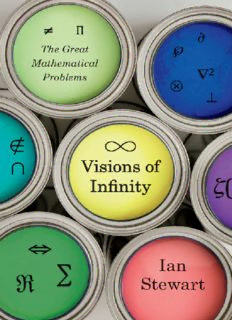
Visions of infinity : the great mathematical problems PDF
Preview Visions of infinity : the great mathematical problems
VISIONS OF INFINITY Also by Ian Stewart Concepts of Modern Mathematics Game, Set, and Math The Problems of Mathematics Does God Play Dice? Another Fine Math You’ve Got Me Into Fearful Symmetry(with Martin Golubitsky) Nature’s Numbers From Here to Infinity The Magical Maze Life’s Other Secret Flatterland What Shape Is a Snowflake? The Annotated Flatland Math Hysteria The Mayor of Uglyville’s Dilemma Letters to a Young Mathematician Why Beauty Is Truth How to Cut a Cake Taming the Infinite/The Story of Mathematics Professor Stewart’s Cabinet of Mathematical Curiosities Professor Stewart’s Hoard of Mathematical Treasures Cows in the Maze Mathematics of Life In Pursuit of the Unknown with Terry Pratchett and Jack Cohen The Science of Discworld The Science of Discworld II: The Globe The Science of Discworld III: Darwin’s Watch with Jack Cohen The Collapse of Chaos Figments of Reality Evolving the Alien/What Does a Martian Look Like? Wheelers(science fiction) Heaven(science fiction) VISIONS OF INFINITY The Great Mathematical Problems IAN STEWART A Member of the Perseus Books Group New York Copyright © 2013 by Joat Enterprises Published by Basic Books, A Member of the Perseus Books Group All rights reserved. Printed in the United States of America. No part of this book may be reproduced in any manner whatsoever without written permission except in the case of brief quotations embodied in critical articles and reviews. For information, address Basic Books, 250 West 57th Street, New York, NY 10107. Books published by Basic Books are available at special discounts for bulk purchases in the United States by corporations, institutions, and other organizations. For more information, please contact the Special Markets Department at the Perseus Books Group, 2300 Chestnut Street, Suite 200, Philadelphia, PA 19103, or call (800) 810-4145, ext. 5000, or e-mail [email protected]. Library of Congress Control Number: 2012924095 978-0-465-02240-3 (hardcover ISBN) 978-0-465-06599-8 (e-book ISBN) Printed in Great Britain in 2013 by Profile Books Ltd. British ISBN: 978-1-84668-1998 10 9 8 7 6 5 4 3 2 1 Contents Preface/ix 1 Greatproblems/1 2 Primeterritory&GoldbachConjecture/16 3 Thepuzzleofpi&SquaringtheCircle/40 4 Mapmakingmysteries&FourColourTheorem/58 5 Spherefulsymmetry&KeplerConjecture/80 6 Newsolutionsforold&MordellConjecture/102 7 Inadequatemargins&Fermat’sLastTheorem/115 8 Orbitalchaos&Three-BodyProblem/136 9 Patternsinprimes&RiemannHypothesis/153 10 Whatshapeisasphere?&Poincare´ Conjecture/176 11 Theycan’tallbeeasy&P/NPProblem/203 12 Fluidthinking&Navier-StokesEquation/214 13 Quantumconundrum&MassGapHypothesis/228 14 Diophantinedreams&Birch–Swinnerton-DyerConjecture/245 15 Complexcycles&HodgeConjecture/258 16 Wherenext?/277 17 Twelveforthefuture/282 Glossary/294 Furtherreading/305 Notes/307 Index/325 We must know. We shall know. David Hilbert Speech about mathematical problems in 1930, on the occasion of his honorary citizenship of Königsberg.1 Preface M athematicsisavast,ever-growing,ever-changingsubject. Among the innumerable questions that mathematicians ask,andmostlyanswer,somestandoutfromtherest:prominentpeaks that tower over the lowly foothills. These are the really big questions, the difficult and challenging problems that any mathematician would give his or her right arm to solve. Some remained unanswered for decades, some for centuries, a few for millennia. Some have yet to be conquered. Fermat’s last theorem was an enigma for 350 years until Andrew Wiles dispatched it after seven years of toil. The Poincaré conjecture stayed open for over a century until it was solved by the eccentric genius Grigori Perelman, who declined all academichonours and a million-dollar prize for his work. The Riemann hypothesis continues to baffle the world’s mathematicians, impenetrable as ever after 150 years. Visions of Infinity contains a selection of the really big questions that have driven the mathematical enterprise in radically new directions. It describes their origins, explains why they are important, and places them in the context of mathematics and science as a whole. It includes both solved and unsolved problems, which range over more than two thousand years of mathematical development, but its main focus is on questions that either remain open today, or have been solved within the past fifty years. Abasicaimofmathematicsistouncover theunderlyingsimplicity ofapparentlycomplicatedquestions.Thismaynotalwaysbeapparent, however, because the mathematician’s conception of ‘simple’ relies on many technical and difficult concepts. An important feature of this book is to emphasise the deep simplicities, and avoid – or at the very least explain in straightforward terms – the complexities. Mathematics is newer, and more diverse, than most of us imagine. At a rough estimate, the world’s research mathematicians number
Description: